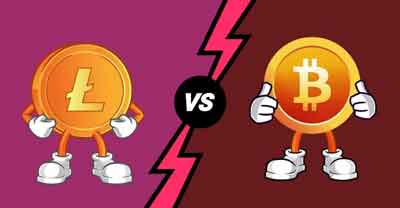Litecoin vs. Bitcoin – Competing or Complementing Bitcoin?

Litecoin is an economically powerful digital currency tool that has a maximum supply limit of 84 million LTC. A successor of Bitcoin, Litecoin was created by former Google & Coinbase engineer Charlie Lee in 2011. Sometimes referred to as “Bitcoin Lite,” Litecoin came into existence due to the hard fork and was devised to eliminate certain shortcomings of Bitcoin. Hence, it copied its codebase and increased the total supply of coins and also the speed of adding newer blocks to the blockchain ledger.
Litecoin is a decentralized, blockchain-secured, uncensored, new-age digital currency with a current market cap of $13.74 billion. Currently valued at $204.14, the future of Litecoin looks promising as per the LTC coin price prediction. By 2022 & 2023, as per this source link, it is expected to reach the $900 mark, making it a good crypto investment option.
Top 5 reasons why Litecoin outranks Bitcoin
1. Advanced Technology
Litecoin is a scrypt based network, while Bitcoin utilizes the SHA-256 mining technology, which is less efficient than Litecoin. Charlie Lee designed scrypt to make the mining process faster, cheaper, safer, and less power-consuming.
2. Innovativeness
Litecoin pioneers technologies like the Lightning Network and Atomic Swaps. While the former is for facilitating instant global fund transfers, the latter is for cross-blockchain trustless trading.
- The Lightning network helps verify transactions from the primary blockchain so that miners can do their work faster. The Lightning Network lets users open their mini-networks called payment channels. The transactions happening via these channels obey the smart contract rules.
- Atomic Swap lets users exchange LTC for BTC in a more straightforward way. All users would need to create a payment channel with another Bitcoin network user and start trading LTC for BTC.
- Segregated Witness (SegWit) blockchain upgrade is another innovation of the Litecoin project that enhances the blockchain’s ability to boost the transaction settlement times, reducing the transaction cost.
3. Extensively decentralized PoW Algorithm
The proof-of-work concept used for bitcoin mining requires miners to use high-powered processors. This makes bitcoin mining more expensive, complex and requires special machines with fully integrated circuit computers with high processing power. In contrast, Litecoin mining requires cheaper systems with less-intensive GPUs (graphics processing units). Thus, Bitcoin mining is more processor-intensive, while Litecoin mining is more memory-intensive, making Litecoin a more decentralized network.
4. Quicker Transaction Speed
As per Blockchain.com, the average block processing time of Litecoin is 2.5 minutes, and Bitcoin is 9 minutes. This is due to the quicker block processing rate of Litecoin.
5. Larger Distribution
Only 21 million BTC can be mined during the mining period; however, Litecoin’s total supply limit is set to a quadruple value of Bitcoins, equal to 84 million LTC.
Conclusion
The key takeaway would be that Litecoin is faster and cheaper than Bitcoins. Litecoin was developed to be a more functional and scalable medium of exchange and is an ever-evolving borderless payment method that enables anyone to transact money globally.